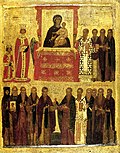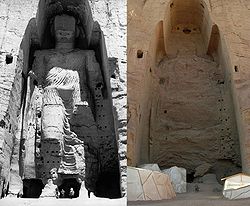Iconoclasm
Iconoclasm is a belief that people should reject religious images (like icons or monuments) by destroying or avoiding them. This is the opposite of idolatry, the worship of icons. Iconoclasm happens during important political or religious changes. It is generally distinct from destruction by foreigners, for example by Spanish conquistadors in America. The term does not generally include the specific destruction of images of a ruler after his death or overthrow (damnatio memoriae), for example Akhenaten in Ancient Egypt.
People who support iconoclasm are called iconoclasts. This word is also used for people who are against established dogmata or conventions. Similarly, people who revere or venerate religious images are called idolators. In an Eastern Orthodox context they are known as iconodules, or iconophiles.
Iconoclasm may be carried out by people of a different religion, but is often the result of sectarian disputes between factions of the same religion. The two Byzantine outbreaks during the 8th and 9th centuries were unusual because the use of images was the main issue in the dispute, rather than a by-product of wider concerns. In Christianity, iconoclasm has generally been motivated by a literal interpretation of the Ten Commandments, which forbid the making and worshipping of "graven images" of God.
Iconoclasm Media
"Triumph of Orthodoxy" over iconoclasm under the Byzantine Empress Theodora and her son Michael III. Late 14th – early 15th-century icon.
Defaced relief of Horus and Isis in the Temple of Edfu, Egypt. Local Christians engaged in campaigns of proselytism and iconoclasm.
Saint Benedict's monks destroy an image of Apollo, worshiped in the Roman Empire
Byzantine Iconoclasm, Chludov Psalter, 9th century
An icon of the Seventh Ecumenical Council (17th century, Novodevichy Convent, Moscow).
Extent (in blue) of the Beeldenstorm through the Spanish Netherlands
In this Elizabethan work of propaganda, the top right depicts men pulling down and smashing icons, while power is shifting from the dying King Henry VIII at left, pointing to his staunchly Protestant son, the boy-king Edward VI at centre.
The taller of the Buddhas of Bamiyan in 1963 and in 2008 after destruction
References
- ↑ "The birth and growth of Utrecht". Archived from the original on 2014-01-16. Retrieved 2008-01-26.






